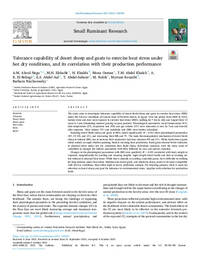Tolerance capability of desert sheep and goats to exercise heat stress under hot dry conditions, and its correlation with their production performance

Authors:
The study aims to investigate tolerance capability of desert Barki sheep and goats to exercise heat stress (EHS) under the hot-dry conditions of Coastal Zone of Western Desert, in Egypt. Over the period from 2009 to 2014, mature ewes and does were exposed to exercise heat stress (EHS); walking for 7 km in July and August from 12 noon to 3 pm (simulating summer grazing on poor pasture). Physiological parameters: rectal temperature (RT), skin temperature (ST), respiratory rate (RR) and gas volume (GV) were measured at rest, by 7am, and directly after exposure. Tidal volume (TV) and metabolic rate (MR) were further calculated.
Exposing desert Barki sheep and goats to EHS, raised significantly (P ≤ 0.01) their physiological parameters (RT, ST, RR, and GV), and decreasing their MR and TV. The main thermoregulatory mechanism of desert Barki sheep to tolerate EHS, was to increase their respiratory heat loss (increase RR and GV). While, Barki desert goats relied mainly on rapid shallow painting, besides reducing heat production. Barki goats showed better tolerance to physical stress under hot dry conditions than Barki sheep. Individual variation, were the main cause of variability in changes the studied parameters with EHS, followed by year and species variation.
Changes in the physiological parameters with EHS were positively (P ≤ 0.05) correlated with body weight at exposure, insignificantly for yearling and weaning weights. Light weight desert lambs and kids at weaning are less tolerant to physical heat stress. While heavy animals at yearling, especially goats, have difficulty in walking for long distance under heat stress. Medium size desert goats, and relatively sheep, seems to be more compatible with hot dry conditions, than either light or heavy performed animals. For breeding purpose, there is room for selection in desert sheep and goat for tolerance to environmental stress, together with selection for production traits.
